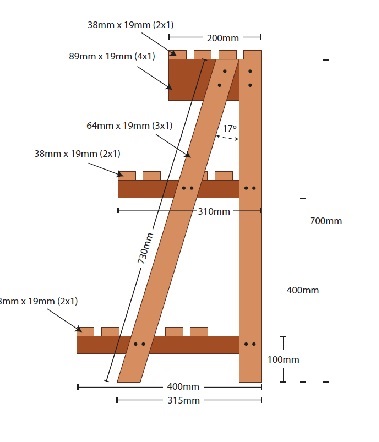Ladder Stands in HomeFarmer
Ladder Stands can be Used to Fit Lots More Plants into a Small Space.
The following is part of an article that John Mason & our staff wrote in 2015, published in Home Farmer Magazine, September 2015
 Whether to make the most of a small garden, or to beautify an outdoor entertaining area, ladder stands are 'stepping' in to help...
Whether to make the most of a small garden, or to beautify an outdoor entertaining area, ladder stands are 'stepping' in to help...
These days as gardens and outdoor spaces diminish in size, many people are looking at ways to make the most use of their available space. One solution is plant stands. They have been around for many years in all sorts of different guises and they allow you to fit more plants into a small area by using vertical space. Pedestals are ideal for highlighting a specimen plant and bonsai often look at their best grouped on garden tables. But the new kid on the block is the ladder stand. It's a variation on a theme, really - they're old-style tiered plant stands with a modern twist. They're made to look a bit like a short set of steps dressed up with plants in pots, and perhaps one or two other embellishments.
Some people are adapting them for indoor use, although you'd need to position them near a window if you want to successfully keep plants on them. So, you'll not only find them in garden centres but also through furniture retailers. It's outdoors though where they really come into their own. You could say they are a way of creating a type of green wall - bringing greenery and colour to a confined area by raising smaller plants closer to eye level and showing off their marvels. A great bonus of this solution is that you have the flexibility to change a display around, keeping your horticultural feature looking at its best throughout the year. If you tire of the look, it's easily changed.
If you're lucky enough to stumble upon an old wooden set of steps, these could easily be adapted for use as a stand. You may need to paint them with a waterproof sealant or use some primer and outdoor paint for a more colourful look. Of course, you could just go out and buy one if you can find the right type. Some are like step ladders and others are more like a-frames with shelving or 'steps' which go from one side to the other. But, why not make your own?
Types of Ladder Stand
If you don't fancy building our plant stand, you could design your own. Perhaps you want something which can be easily transported or moved around the garden? If so, why not make something modular? You could build each step so that it could be stacked and secured but quickly dismantled if needed. You could have more than one stand sitting adjacent to each other.
Another possibility would be to build one from timber planks set on stacks of bricks. This would require less skill to construct and once again could be disassembled if you no longer want it.
Other Things to Consider
Ladder stands can be made from many materials.
Wood - this is easy to use for DIY projects. It is a renewable resource, and is not particularly expensive unless you choose some of the rarer hardwoods.
Metal - this is not so easy to work with. You may be able to salvage predrilled and cut pieces. If buying new, cast iron and aluminium are expensive.
Plastic - this is not ideal for ladder stands. It may scratch, is susceptible to UV damage outdoors, and is not easy to repair. But it is cheap.
Maintenance & Durability
Outdoors, plant stands are exposed to the elements - even if they are protected by a veranda. What's more, you'll be watering your plants and splashing water around when you do so. Therefore, you're going to have to look after your stand.
Wood - to prevent rot, this will need to be hardwood or treated softwood. Tanalised timber is wood that is already impregnated with preservative and is fit for outdoor use. Untreated wood will need to be coated with a couple of coats of preservative even if you intend to paint it. Paint will last longer than stain but is more expensive and needs a couple of undercoats. Waxes and oils look more natural, but will need reapplying every couple of years.
Metal - rust is the biggest problem since it thrives on air and water. If left untreated it will cause decay. Iron is most prone - stainless or galvanised steel and aluminium, much less so. Some may be constructed of powder-coated steel or plated with non-corrosive metals which should last well. To prevent rust metals will need to be oiled or greased, or painted with a suitable metal paint.

For this and other articles by our staff; -See Home Farmer Magazine - on sale across the UK, Monthly. We are regular contributors to this magazine.
[03/01/2026 07:51:44]
More from ACS
Over 150 short courses, certificates and diplomas covering landscaping, crops, plants of all types and general gardening.